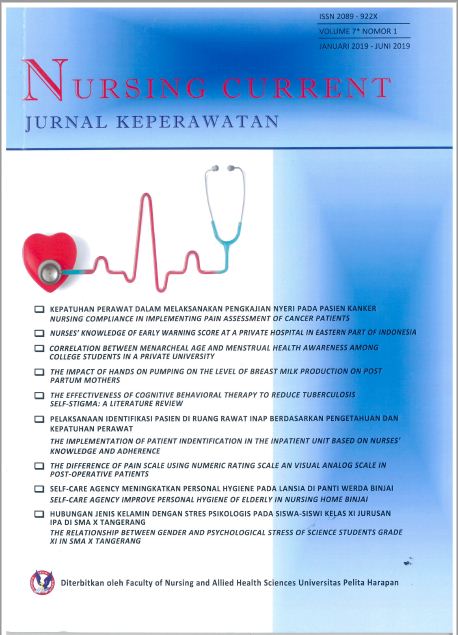NURSE COMPLIANCE IN CARRYING OUT PAIN ASSESSMENT IN CANCER PATIENTS [KEPATUHAN PERAWAT DALAM MELAKSANAKAN PENGKAJIAN NYERI PADA PASIEN KANKER]
DOI:
https://doi.org/10.19166/nc.v7i1.2122Schlagworte:
Kepatuhan perawat, pasien kanker, pengkajian nyeri, nurse compliance, cancer patients, pain assessmentAbstract
Pain is a frightening thing and symptoms that are very complained of by patients with a diagnosis of cancerIn order to provide nursing care for pain, nurses need to carry out an accurate pain assessment. Pain assessment in one of the hospital is usually conducted by referring to the Standard Operating Procedures (SOP). However, nurses do not comply with this SPO so that there is a difference in the data obtained from thquality assurance section of a hospital with reality in the field. The purpose of this study was to determinnurses' compliance in implementing standard operating procedure (SOP) for pain assessment in a privatehospital in Central Indonesia. This research method is quantitative descriptive design. The population of thisstudy were 83 nurses who worked actively in the hospital's chemotherapy room, with a total sample of 30 nurses, taken by purposive sampling technique. The results showed that the level of nurse compliance inconducting pain assessment was as follows: almost most nurses (90%) were in good categories and 67% nurses (20 people) conducted repeated pain assessments in good categories. Nurses play an important role inconducting pain assessment and management in patients therefore the nursing care becomes more effective.Further research can focus on factors that influence nurse compliance in implementing pain assessment in cancer patient.
BAHASA INDONESIA Nyeri merupakan hal yang menakutkan dan gejala yang sangat dikeluhkan oleh pasien dengan diagnosa kanker. Agar dapat memberikan asuhan keperawatan terhadap nyeri, perawat perlu melakukan pengkajian nyeri yang akurat. Pengkajian nyeri di salah satu rumah sakit biasanya dilakukan dengan mengacu pada Standar Prosedur Operasional (SPO). Namun seringkali perawat tidak mematuhi SPO ini sehingga terjadi perbedaan data yang diperoleh dari bagian penjaminan mutu suatu rumah sakit dengan kenyataan di lapangan. Tujuan penelitian ini adalah mengetahui kepatuhan perawat dalam melaksanakan SPO pengkajian nyeri di sebuah rumah sakit swasta di Indonesia Bagian Tengah. Metode penelitian ini adalah desain deskriptif kuantitatif. Populasi penelitian ini adalah 83 perawat yang bekerja aktif di ruang kemoterapi rumah sakit tersebut, dengan jumlah sampel 30 perawat, yang diambil dengan teknik purposive sampling. Hasil penelitian menunjukkan bahwa tingkat kepatuhan perawat dalam melakukan pengkajian nyeri sebagai berikut: hampir sebagian besar perawat (90%) berada dalam kategori baik dan 67% perawat (20 orang) melakukan pengkajian nyeri secara berulang berada dalam kategori baik. Perawat memegang peranan yang penting dalam melakukan pengkajian dan manajemen nyeri pada pasien agar asuhan menjadi efektif. Penelitian selanjutnya dapat berfokus pada faktor - faktor yang memengaruhi kepatuhan perawat dalam melaksanakan pengkajian nyeri pada pasien kanker.
Literaturhinweise
Arikunto, S. (2006). Prosedur penelitian suatu pendekatan praktek. Jakarta: Rineka Cipta
Aziz, F., Rasjidi, I., & Witjaksono, J. (2008). Panduan pelayanan medik. Jakarta: Buku Kedokteran EGC
Bartoszczyk, D., & Gilbertson-White, S. (2015). Interventions for Nurse-Related Barriers in Cancer Pain Management. Oncology Nursing Forum, 42(6), 634-641. https://doi.org/10.1188/15.ONF.634-641
Breivik, H., Cherny, N., Collett, B., Conno, F. D., Filbet, M., Foubert, A., . . . Dow, L. (2009). Cancer-related pain: A pan-European survey of prevalence, treatment, and patient attitudes. Annals of Oncology, 20(8), 1420-1433. https://doi.org/10.1093/annonc/mdp001
Gordon, D. B., Rees, S. M., Mccausland, M. P., Pellino, T. A., Sanford-Ring, S., Smith-Helmenstine, J., & Danis, D. M. (2008). Improving Reassessment and Documentation of Pain Management. The Joint Commission Journal on Quality and Patient Safety, 34(9), 509-517. https://doi.org/10.1016/S1553-7250(08)34065-3
Gustafsson, M., & Borglin, G. (2013). Can a theory-based educational intervention change nurses’ knowledge and attitudes concerning cancer pain management? A quasi-experimental design. BMC Health Services Research, 13(1). https://doi.org/10.1186/1472-6963-13-328
Margonari, H., & Hannan, M. S. (2017). Quality improvement initiative on pain knowledge, assessment, and documentation skills of pediatric nurses. Pediatric Nursing, 43(2), 65-70. PMID: 29394479
Everdingen, M. V., Rijke, J. D., Kessels, A., Schouten, H., Kleef, M. V., & Patijn, J. (2007). Prevalence of pain in patients with cancer: A systematic review of the past 40 years. Annals of Oncology, 18(9), 1437-1449. https://doi.org/10.1093/annonc/mdm056
Nazvia, N., Loekqijana, A., & Kurniawati, J. (2014). Faktor yang Mempengaruhi Kepatuhan Pelaksanaan SOP Asuhan Keperawatan di ICU-ICCU RSUD Gambiran Kota Kediri. Jurnal Kedokteran Brawijaya, 28(1), 21-25. https://doi.org/10.21776/ub.jkb.2014.028.01.17
Pamuji, T., Asrin & Kamaludin, R. (2008). Hubungan pengetahuan perawat tentang standar prosedur operasional (SPO) dengan kepatuhan perawat terhadap pelaksanaan SPO profesi pelayanan keperawatan di instalasi rawat inap RSUD Purbalingga. Jurnal Keperawatan Soedirman (The Soedirman Journal of Nursing), 3(1).
Ramira, M., Instone, S., & Clark, M. (2016). Pediatric Pain Management: An Evidence-Based Approach. Pediatric Nursing, 42(1), 39-46, 49. https://www.ncbi.nlm.nih.gov/pubmed/27019942
Samarkandi, O. (2018). Knowledge and attitudes of nurses toward pain management. Saudi Journal of Anaesthesia, 12(2), 220. https://doi.org/10.4103/sja.SJA_587_17
Sugiyono. (2013). Metode penelitian pendidikan pendekatan kuantitatif, kualitatif, dan R&D. Bandung: Alfabeta.
World Health Organization (2017). Cancer. http://www.who.int/cancer/en/
Downloads
Veröffentlicht
Zitationsvorschlag
Ausgabe
Rubrik
Lizenz
Authors who publish with this journal agree to the following terms:
1) Authors retain copyright and grant the journal right of first publication with the work simultaneously licensed under a Creative Commons Attribution License (CC-BY-SA 4.0) that allows others to share the work with an acknowledgement of the work's authorship and initial publication in this journal.
2) Authors are able to enter into separate, additional contractual arrangements for the non-exclusive distribution of the journal's published version of the work (e.g., post it to an institutional repository or publish it in a book), with an acknowledgement of its initial publication in this journal.
3) Authors are permitted and encouraged to post their work online (e.g., in institutional repositories or on their website). The final published PDF should be used and bibliographic details that credit the publication in this journal should be included.

This work is licensed under a Creative Commons Attribution-ShareAlike 4.0 International License.






